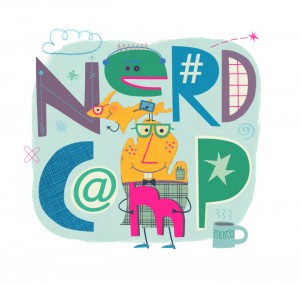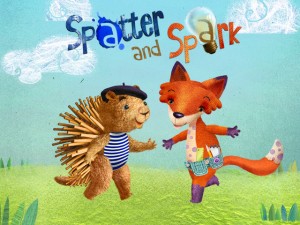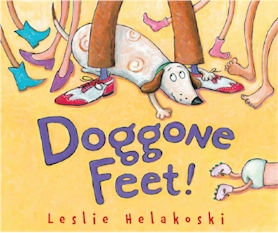Nerd Camp and Twitter
 Yesterday I attended nErD Camp, a free, education “unconference” presented by the Nerdy Book Club. For a day and a half, teachers from all over the states came to Parma, Michigan to share ideas about literacy and learning. I led a small session about using public libraries to get kids and teachers the materials they need year-round. I joined sessions on using graphic novels and picture books at all levels and on using Google Docs with forms and add-ins to organize kids’ writing and promote collaboration. (Email me if you want details.)
Yesterday I attended nErD Camp, a free, education “unconference” presented by the Nerdy Book Club. For a day and a half, teachers from all over the states came to Parma, Michigan to share ideas about literacy and learning. I led a small session about using public libraries to get kids and teachers the materials they need year-round. I joined sessions on using graphic novels and picture books at all levels and on using Google Docs with forms and add-ins to organize kids’ writing and promote collaboration. (Email me if you want details.)
Nerd Camp, Jr. was in the evening. Hundreds of kids got to meet authors and illustrators, talk about reading and writing, and score free books. Matt Faulkner, Ruth McNally Barshaw, Linda Urban, Laurie Keller, and others wowed the crowd. (Laurie Keller designed the Nerd Camp logo. Isn’t it fantastic?)
My brain is spinning with new ideas and my appreciation for teachers is even greater than it was before. In July, when most teachers are finally able to enjoy a break, these folks came for a professional development event and generously shared what they knew. I am inspired by you all. Thanks to Colby and Alainna Sharp, Donalyn Miller, Kristin McIlhagga, and the entire Nerdy Book Club powerhouse. nErD Camp 2015 is already in the works if you want in on the fun.
And thank you, Nerds, for pulling me into the world of Twitter! You can follow me @RemenarReads. I promise to tweet only about literacy and books (saving my crazy cat photos for Facebook).
Read MoreFree, safe images for students
 Let’s imagine that you and your students have gone on a field trip to the Henry Ford Museum in Dearborn, Michigan (which, if you can, I highly recommend that you do so because the place is a-ma-zing.) Imagine one of your students wants to write about his favorite part of the trip – seeing the Oscar Meyer Wienermobile. He didn’t take any photos on the trip, so he wants to search for images online to add to his writing. Imagine what might happen if your student uses a typical search engine to look for images of wienermobiles.
Let’s imagine that you and your students have gone on a field trip to the Henry Ford Museum in Dearborn, Michigan (which, if you can, I highly recommend that you do so because the place is a-ma-zing.) Imagine one of your students wants to write about his favorite part of the trip – seeing the Oscar Meyer Wienermobile. He didn’t take any photos on the trip, so he wants to search for images online to add to his writing. Imagine what might happen if your student uses a typical search engine to look for images of wienermobiles.
Now imagine that you are a highly-prepared, tech-savvy teacher (easy to do, because you so are.) When your students want to add images of a wienermobile, or a titmouse, or any image, you guide them to search on Pics4Learning. It’s safe, it’s free, and the images are copy-right friendly.
Before you open up Pics4Learning, imagine the joy every artist will feel if you give your students a quick lesson on copyright first. Ask your students to imagine that they have worked tirelessly to create a fantastic work of art. Imagine posting a photo of said masterpiece online to share your art with family and friends. Now imagine that some random person online decides to right-click the photo of your masterpiece, copy and paste it, and use your work as if they made it. Imagine the outrage! Now your students may understand how artists feel when their images are copied and taken without any recognition or attribution. Just because you *can* right-click and copy an image doesn’t mean you *should*. Use a site like Pics4Learning instead, and there will be no breaking of copyright issues, or any uncomfortable discussions about when searching for images of blue-footed boobies.
Read MoreSpatter and Spark – a free picture book app!
 Perhaps my dilemma is familiar to you. I have an iPad, and I want a great picture book app to share with early elementary students. With my tiny budget I’m always on the hunt for the free, but I also like good stuff, and unfortunately, that combination of free and good is often hard to find. Here’s an app that fits the bill – Spatter and Spark.
Perhaps my dilemma is familiar to you. I have an iPad, and I want a great picture book app to share with early elementary students. With my tiny budget I’m always on the hunt for the free, but I also like good stuff, and unfortunately, that combination of free and good is often hard to find. Here’s an app that fits the bill – Spatter and Spark.
Spatter and Spark is a free picture book app from Polk Street Press. It’s an original story written by the talented and rockin’ cool Deborah Underwood with superb illustrations by Luciana Navarro Powell. Spatter is an artistic porcupine who would like to paint a picture of the baby crow, Hubert, as a gift. The problem is that Hubert is not quite ready to fly down from his nest, so Spatter isn’t sure what Hubert looks like. Spatter asks his inventor pal, Spark, to help him with his problem. She suggests that if Hubert can’t come down, Spatter should go up. Spark invents bouncy shoes for her and Spark to wear and the problem seems solved – until they are bouncing too high! The reader helps to save the day, and that’s one of the best things about apps like this: they encourage reader interaction.
The art for Spatter and Spark is large enough for a whole class to enjoy, but I think it’ll be best used either in small groups or 1-to-1 because readers can help build and paint the bouncy shoes (Spatter is an artist and must make the shoes sparkly!) I love how the shoes we see Spatter and Spark wearing as they bounce are painted exactly the way I chose, a bit of tech magic that delights me. There are activities within the app that can be purchased, but I want to use this with students to talk about Key Ideas and Details.
This story starts with one problem, but one answer doesn’t automatically save the day; the solution leads to another problem. After sharing this picture book app with your students, have them fold or divide a piece of paper into thirds labeled First, Next, and Last (or keep it teched up by using a “show me” app like Educreations to write and draw). In the “First” third, students can show the original problem. In the “Next” third, students can show the solution to that problem, which also caused another problem! In the “Last” third, students can show how that second problem was solved.
Because Spark is an inventor, ask your students to get creative. Bouncy shoes were one way for the friends to get up high – what other ways might there be? Encourage students to draw (or create!) another invention that might work, and make sure to plan for any problems this new solution might cause. In honor of artistic Spatter, students should make the inventions beautiful as well as functional. (Gotta say, I love that the girl is the inventor and the boy is artistic!)
So if you have an iPad 2 or later, and you’re on the hunt for a free picture book that’s also high-quality, download Spatter and Spark!
For more information about Deborah Underwood, please visit: www.deborahunderwoodbooks.com.
For more information about Luciana Navarro Powell, please visit: www.lucianaillustration.blogspot.com.
For more information about Polk Street Press, please visit: www.polkstreetpress.com
Read More
Doggone Feet is Doggone Fun!
 There are many perks to being a children’s librarian (no overdue fines has saved me a bundle over the years) but one of the best parts of my job is getting to know supah-cool authors and illustrators like Leslie Helakoski. Leslie is a Michigan treasure I’ve had the pleasure of knowing for years, and I’m geeked to share her brand new book with you: Doggone Feet.
There are many perks to being a children’s librarian (no overdue fines has saved me a bundle over the years) but one of the best parts of my job is getting to know supah-cool authors and illustrators like Leslie Helakoski. Leslie is a Michigan treasure I’ve had the pleasure of knowing for years, and I’m geeked to share her brand new book with you: Doggone Feet.
Dog follows a pair of feet home from the park one day and finds her perfect place under the table. Life is good until two more feet come on the scene:
“They’re twirling leg twisters, toe-tapping kiss-kissers,
rule-listing insisters of doggy shampoos.”
So now the space under the table includes the dog and two sets of two feet, until another pair come along – tiny baby feet. As the family grows the dog must accommodate more pairs of feet in her shrinking space, and she’s not sure she likes the new additions. In the end, though the space under the table is crowded and cramped, the message is clear: families always make room for more.
The first time I read this book, I immediately thought how it perfect it would be for a math lesson. If there were two dogs and three humans, how many feet would be under the table? It’s also a great book to talk about point of view – both figuratively and literally. The story is told from the dog’s perspective, and we don’t see the faces of the humans, just their feet, until the end of the book. You can talk with your students about author/illustrator’s Craft and Structure – why did Ms. Helakoski choose to frame all the illustrations from this different point of view? How might a mouse see life under a dinner table, or a fly over a school cafeteria table at lunchtime? It’d be fun to have students spend a writing session on the floor under their desks, to inspire them to write and draw from a different point of view.
Then I saw the terrific trailer that Leslie’s son, Connor, made for her book:
How cool would it be to combine book-trailer technology with a math lesson centered around Doggone Feet?! Using a free app like Educreations on the iPad or a program like iMovie on computers, students could make a mini-movie to retell the events of the story (check off Key Ideas and Details on your Common Core State Standards score card) either by drawing the action or physically acting it out, adding up the feet as you go. With all the wonderful rhyme and wordplay, it’d be great for Reader’s Theater! Doggone Feet will be so doggone much fun for your students!
For more information, please visit Leslie’s website at helakoskibooks.com.
Read More






